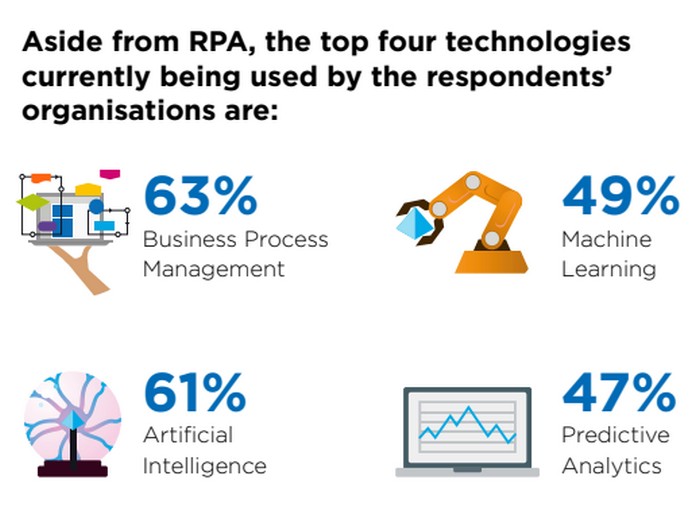A Blue Prism report titled “RPA In The APAC Financial Services Sector” reveals a significant disparity of robotic process automation (RPA) use within Asia Pacific’s financial services industry. Australia leads the way with 78% of surveyed individuals claiming their organisations currently using RPA solutions and technologies, India ranked second at 49%, followed by Hong Kong (47%), Malaysia (44%) and Singapore (28%).
With only 34% in Singapore and 50% in Malaysia of respondents indicating familiarity with RPA, there is potential for better comprehension and perception around this technology. This is in comparison to 85% in Australia, 82% in Hong Kong and 75% in India.
Robert Dewar, vice president, financial services, APAC, Blue Prism, noted that the disparity suggests the region has a long way to go before reaching RPA and Intelligent Automation maturity.
Usage of RPA


He added that the current usage of RPA remains largely as a tool to improve efficiency and cut costs, rather than a catalyst to accelerate digital transformation.
“As markets look to scale up to enterprise RPA and Intelligent Automation deployments, our aim is to empower companies to fulfil their vision for strategic business automation and achieve faster better organisational outcomes,” he continued.
Perceived benefits
According to respondents, 95% felt RPA has improved overall business operations, with 50% citing cost and time savings, 24% noting a reduction in manpower or burden of administrative personnel, and 14% cited increased accuracy and quality of output. Only 12% of respondents acknowledged RPA as a catalyst for driving digital transformation.
RPA use by the department at present
Not surprising that the finance department ranked as the most prolific user of RPA. IT ranked second in Australia, India, Malaysia and Singapore. In Hong Kong, the customer service department took the second spot as the most active user of RPA.
Near-term plans for RPA

In the near term, the survey suggests that things will remain much the same for companies in Australia, Hong Kong and India. Not so in Malaysia where sales and marketing are expected to ramp up RPA adoption over the next 2-3 years.
Surprisingly, the finance department was not included in the top three areas that Singapore companies will be leveraging RPA in the near term, with companies ranking IT departments (61%) as the top priority for RPA adoption, followed by sales and marketing (54%) and customer service (50%).
Australia
- 99% of organisations believed that RPA has improved overall business operations, including cost and time savings (88%) and increased accuracy and quality of output (76%).
- Organisations ranked top considerations when drawing RPA budgets to implementation costs (77%) as the most important factor, followed by maintenance costs (70%) and ancillary costs (67%)
- Of the organisations that are not currently using RPA solutions and technologies (22%), 8% are planning to implement such technologies within the next six months, and 4% are planning to do so within the next year
• 89% of organisations said that the future growth of RPA is promising
Hong Kong
- 96% of organisations felt that RPA has improved overall business operations, with significant benefits in cost and time savings (69%), and increased accuracy and quality of output (69%)
- When drawing up an RPA budget, most organisations ranked implementation costs (65%) as the most important factor, followed by ancillary costs (60%) and maintenance costs (59%)
- 52% of organisations are not currently using RPA solutions and technologies; 31% are planning to implement such technologies within the next six months, and 8% are planning to do so within the next year
- 85% of organisations said that the future growth of RPA is promising
India
- 95% of organisations felt that RPA has improved overall business operations, with cost and time savings (83%) as the most significant benefit, and as a catalyst for driving digital transformation (76%)
- When budgeting for RPA, 75% of organisations ranked implementation costs as the most important factor, followed by maintenance costs (62%) and ancillary costs (44%)
- Among those not currently using RPA solutions and technologies (50%), 27% intend to implement within the next six months, and 11% within the next year
- 93% of organisations said that the future growth of RPA is promising
Malaysia
- 93% of organisations felt that RPA has improved overall business operations, with increased efficiencies and speed within the organisation as the most main driver of RPA adoption (86%), followed by allowing workers to concentrate on higher-value tasks (70%) and reducing errors (68%)
- When drawing up an RPA budget, implementation costs (69%) is the most important factor, followed by maintenance costs (62%), ancillary costs (49%) and business process value (49%)
- Within the next two to three years, 41% of organisations expect to invest approximately up to 50% of their total automation budget in RPA, and 36% of organisations expect to invest approximately up to 75% of their total automation budget in RPA
- Of the 56% of organisations that are not currently using RPA solutions and technologies, 13% are planning to implement such technologies within the next six months, and 16% are planning to do so within the next year
- 84% of organisations said that the future growth of RPA is promising
Singapore
- 79% of organisations felt that RPA has improved overall business operations, with a reduction in manpower or burden of administrative personnel (68%) as the most significant benefit, and RPA as a catalyst for driving digital transformation (68%)
- When drawing up an RPA budget, maintenance costs (88%) is the most important factor, followed by implementation costs (59%) and ancillary costs (59%)
- 71% of organisations said that the future growth of RPA is promising





